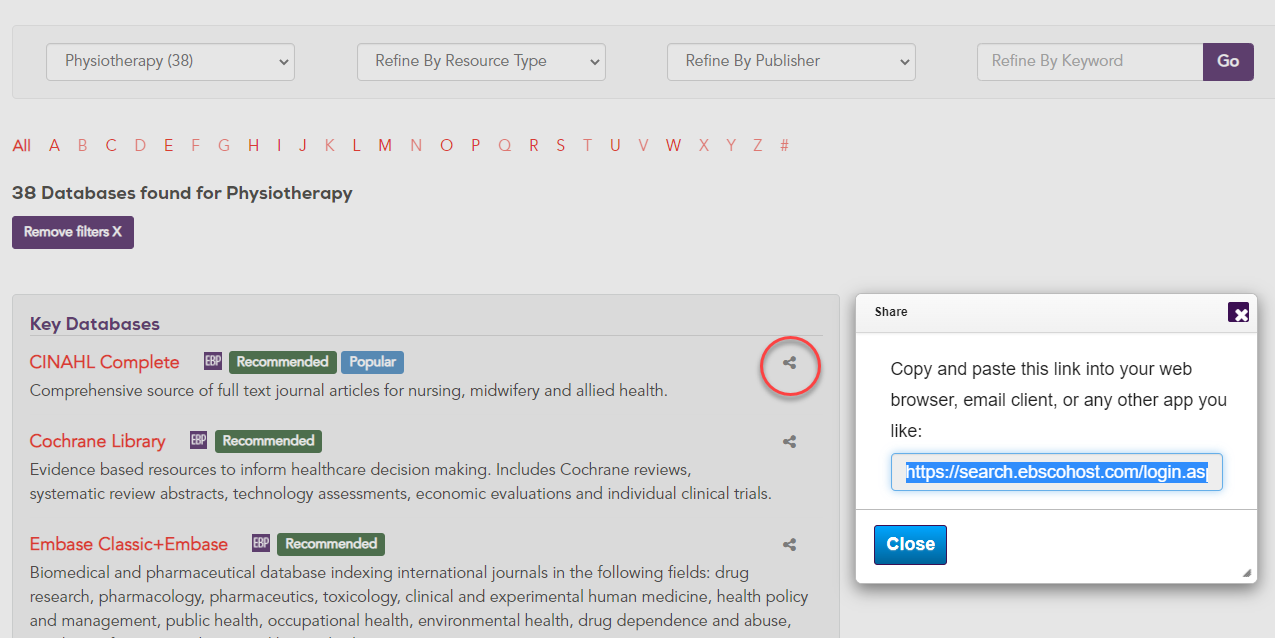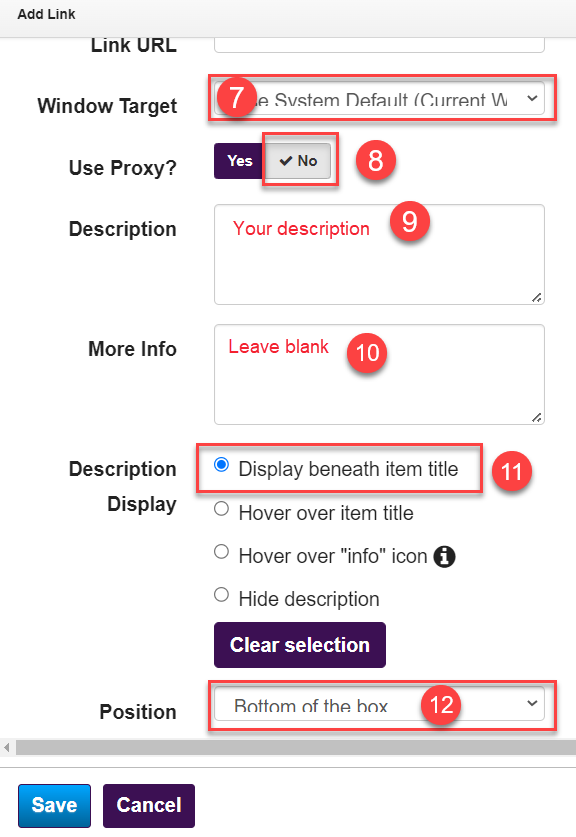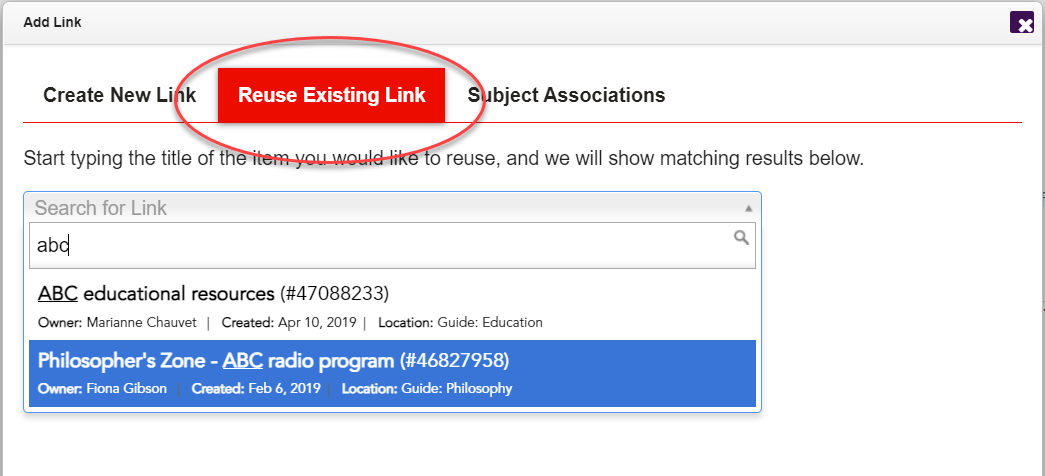Procedures & help
Formal procedures and best practice guidelines for LibGuides can be found in the Library share drive N:\Library\Services\Library Guides\2020 Library Online Learning and Teaching Resources Procedures and Best Practice Guidelines.pdf. These should be read first.
This guide contains practical guidance on creating and/or editing guides with step by step instructions and ACU library preferred options.
Contact Library Help anytime for assistance.
You can also post questions to the Library LibApps Workplace group.
Getting started
It is highly recommended to look at Springshare's suite of beginning training videos before creating/editing a guide for the first time. Follow the help link in the top navigation menu bar once logged into LibGuides.
You must use one of our two templates to begin:
These contain the preferred layout and example boxes that you can re-use/edit.
If you require a different layout, please contact library help.
Re-using assets
Before adding any resources to your guide, please search to see if it exists in the libguide system already. Otherwise items are duplicated and our asset list becomes difficult to maintain.
Warning: copy and pasting
Copying and pasting directly from other programs, such as MS Word or Powerpoint, brings across unnecessary and junk code.
If you wish to copy from another program, first strip the formatting by pasting it into Notepad (comes standard on all ACU computers). Copy your content from Notepad and paste it into your Libguide box. You can then format it using the headings and other options in the WSIWYG editor.
Adding databases
- Choose Add/Reorder > Database to add databases, ebook collections, ejournal collections or any item in the A-Z list.
- These assets are created by Systems & Discovery for the Databases A-Z list. If the database you require is not included, please contact library help to have it added.
- You may customise the description if you like. Try to keep it under 2 sentences. If you would like the description changed at a global level, please contact library help.
- Keep the description display default (display beneath item title).
- Position in the list is your choice.
- Detailed instructions for adding a databases can be found at springshare help: https://ask.springshare.com/libguides/faq/934

Finding a database link
Sometimes you may need the direct link to a database, for example you are adding it in inside some text. To get the URL you can go to the Databases A-Z page and use the "share" link. Use the URL as is, it already includes authentication.

Adding resources from Primo (library search)
Using permalinks from the library catalogue is the preferred method for linking to library resources such as ebooks and ejournals.
Reasons include:
- It is unlikely links will break.
- Resources are configured for remote access automatically.
- Any changes in Alma are automatically updated.
- Users can choose their preferred platform to access content when there is more than one option (eg html vs pdf version, different date access for journals).
- Users can use the functions of My Library such as pinning/endnote/citation etc.
Adding ejournals / articles / videos
- Select Add/Reorder > Link.
- Select the second tab Reuse Existing Link and search for an existing asset.
- If one is there - select it. Do not tick make a copy. Any changes you make on your link will not affect the original link. Save.
- If there is no existing asset, go to the Create New Link tab.
- For URL, paste in the primo record (library search) permalink.
- For Use Proxy? Select No.
- Customise a short description and save.
Adding ebooks
- Select Add/Reorder > Book from the catalog.
- Select the second tab Reuse Existing Book and search for an existing asset.
- If one is there - select it. Do not tick make a copy. Any customisations you make will not affect the original asset. Save.
- If there is no existing book, go to Create New Book tab.
- Search via ISBN and most fields should populate.
- For URL, use the primo record (library search) permalink.
- For Use Proxy? Select No.
- Customise a short description and save.
Adding physical/print resources
Electronic resources are preferred for use in libguides. Any physical resources will require approval from the Associate Director Libraries, Client Services.
Physical items are added in the same manner as for ejournals or ebooks above.
Adding websites or non-subscription resources
Includes government websites, open access resources or items without subscription not in the A-Z list.
- Select Add/Reorder > Link.
- Select the second tab Reuse Existing Link and search for an existing asset.
- If one is there - select it.
- Do not tick make a copy. Any changes you make on your link will not affect the original link. Save.
- If there is no existing asset, go to Create New Link tab.
- Fill in link name and URL.
- Window target > keep default.
- Use proxy? > No.
- Customise a short description.
- More info > leave blank.
- Description display > leave default.
- Position > your choice.

- Assign resource icon > optional. Contact library help to have a new icon added.
- Assign Thumbnail image > optional. Use the Browse function to upload an image to the media library. External URLs are not recommended.

Deep linking
Deep links are useful for ebook chapters or items not available in the catalogue such as articles or videos inside databases.
Adding a deep link
- Select Add/Reorder > Link.
- Select the second tab Reuse Existing Link and search for an existing asset.
- If one is there - select it.
- Don't tick make a copy. Any changes you make (such as description or link name) will not affect the original asset, but the URLs will be linked and updated together. Save.
- If there is no existing asset, go to Create New Link tab.
- For URL, find a permanent/stable or DOI link, then use it in the Open Athens link generator. See the generator for further information or contact library help.
- Paste in the generated URL.
- For Use Proxy? Select No.
- Customise a short description and save.

Inserting a table
Accessible tables need HTML markup that indicates header cells <th> and data cells <td> and defines their relationship. Assistive technologies use this information to provide context to users.
You can use the WSIWYG editor in libguides to insert a table that will mark up the headings and data for you. You must make sure to select which columns/rows are headings before you start entering data.
Alternatively, re-use one of the example tables in the next section and edit for your purposes.
The most common table we use is one with two headings (column and row). Please use these settings:

| Heading one | Heading two | Heading three | |
|---|---|---|---|
| Row heading one | data | data | data |
| Row heading two | data | data | data |
| Row heading three | data | data | data |
| Row heading four | data | data | data |
Do not use tables as a way to format content. It can introduce reading and navigation order issues. Screen readers may interpret them as data tables (i.e., announcing column and row numbers), causing significant overhead on screen reader users.
See Tables Tutorial | Web Accessibility Initiative (WAI) | W3C for further information.
Responsive table
Wrap tables in <div class="table-responsive"> </div> to get responsive tables that display a scroll bar on small screens. (The code that formats this is in the springshare default CSS file - tables.less)
Example table
Which reference management tool is best for me?
| Feature | EndNote Desktop | Mendeley Reference Manager | Zotero |
|---|---|---|---|
| Ease of use | Harder to learn initially | Easy to use | Easy to use |
| Cost | Free for ACU staff and students | Free | Free (up to 300 MB) |
| Storage capabilities | Unlimited |
Free account: 2GB ACU Institutional Edition: 100GB |
300 MB (users can pay for extra storage beyond 300 MB) |
| Software support |
ACU Library supports EndNote (guide, webinars and consultations) EndNote website provides online training materials |
ACU Library guide Mendeley website provides online training materials |
ACU Library guide Zotero website provides online training materials |
| Word processor compatibility |
Microsoft Word Apache OpenOffice Apple Pages LibreOffice |
Microsoft Word OpenOffice LibreOffice NeoOffice |
Microsoft Word LibreOffice OpenOffice NeoOffice Google Docs |
| Number of reference styles | Over 6,000 styles | Over 10,000 styles via the Citation Style Language (CSL) repository | Over 8,000 styles via the Style Repository |
| Operating system compatibility | Windows, Mac | Windows, Mac OS X or later, Linux | Windows, Mac, Linux |
| Syncing |
Cloud storage and syncing via EndNote Web. Register for an account. |
Cloud storage and syncing available. Register for an account. |
Cloud storage and syncing available. Register for an account. |
| Advantages |
Premium product Advanced features Easily customised Easy to edit reference styles Supported by ACU |
Easy to use Collaborative, social networking functionality |
Easy to use Great for importing records from non-traditional sources such as websites |
| Best suited to | Users comfortable with reference management systems. |
Undergraduates who have never used a reference management system. Researchers sharing papers and networking. |
Undergraduates who have never used a reference management system. |
Floating tables
| First Name | Last Name |
|---|---|
| Jill | Smith |
| Eve | Jackson |
| Adam | Johnson |
| First Name | Last Name |
|---|---|
| Jill | Smith |
| Eve | Jackson |
| Adam | Johnson |
*add css to individual guide to make this work.
Adding a video from YouTube
New ACU library video
Send a request to library help and ask for:
- the video to be uploaded to the Library's YouTube channel
- a playlist URL be created
- for it to be added to LibGuides as a media asset.
Existing ACU library YouTube video
- Select Add/Reorder > Media/Widget.
- Select the second tab Resuse Existing Widget and search for the title.
- Select the video.
- Don't tick make a copy. Save.
- If the video is not there, ask library help to add it to LibGuides.
Other YouYube video
- Get the embed code from YouTube by selecting Share > Embed.
- Scroll down and tick Enable privacy-enhanced mode.
- Select copy.

- In libguides, select Add/Reorder > Media/Widget.
- Name the video and paste in your embed code.
- Save.
**discontinued** Example contact box
Firstname Lastname
Senior Library Coordinator, Subject/discipline/faculty | Campus
T: +61 X XXXX XXXX E: firstname.lastname@acu.edu.au
Firstname Lastname
Senior Librarian, Subject/discipline/faculty | Campus
T: +61 X XXXX XXXX E: firstname.lastname@acu.edu.au
If you do not want to list individuals, link to the library contact page or the LARS contact page.
Publishing
Once your guide is finished and approved by the guide owner, you can submit it for final checking and publication. Have a look at the short video below or follow these steps:
- Click on 'Published/Unpublished'
- Change Status to 'Share'
- Under 'Publication Status' select 'Submit for Review'
- Add a Message to tell us what changes were made (e.g. new guide to go live, new page titled 'x' added, new box titled "x" added, New LibWizard tutorial added etc.)
- Click 'Save' & Close
Systems & Discovery will review the guide and liaise with the guide owner about any changes that might be required.
Guide maintenance & review
Guides should be reviewed and updated once per semester.
You need to:
- Test each link – preferably from off-campus without VPN. The link should resolve properly/not produce any errors. Also check the content of the website. Is it still correct? Has the name or site changed? Is the content that you were expecting still there? These types of changes are NOT detected by the broken link checker, so are especially important to check for in non-database links.
- Update the ACU Library Guide Owners & Editors document on the share drive with a new review date and any other relevant details.
You may like to:
- Analyse your guide and asset statistics.
- Check content for currency.
- Add any new databases or resources that have recently been purchased by the library.